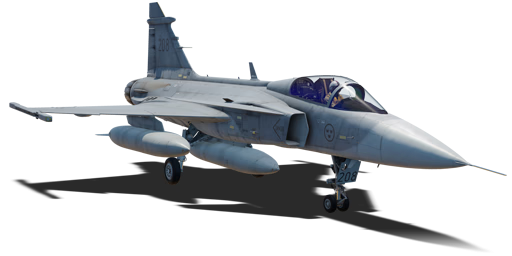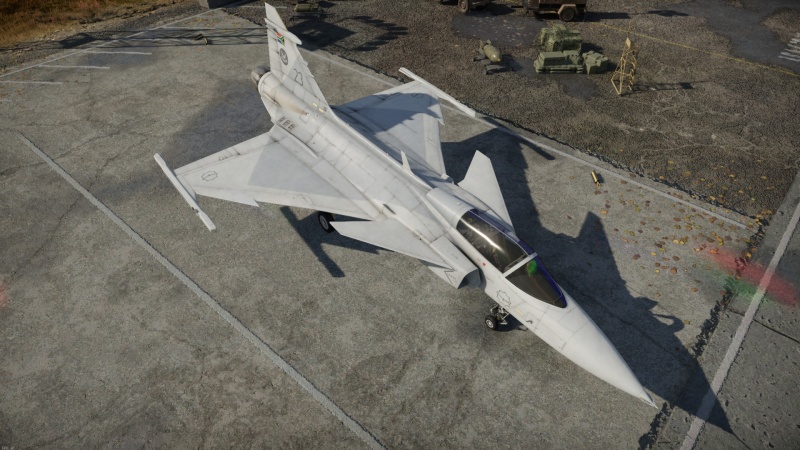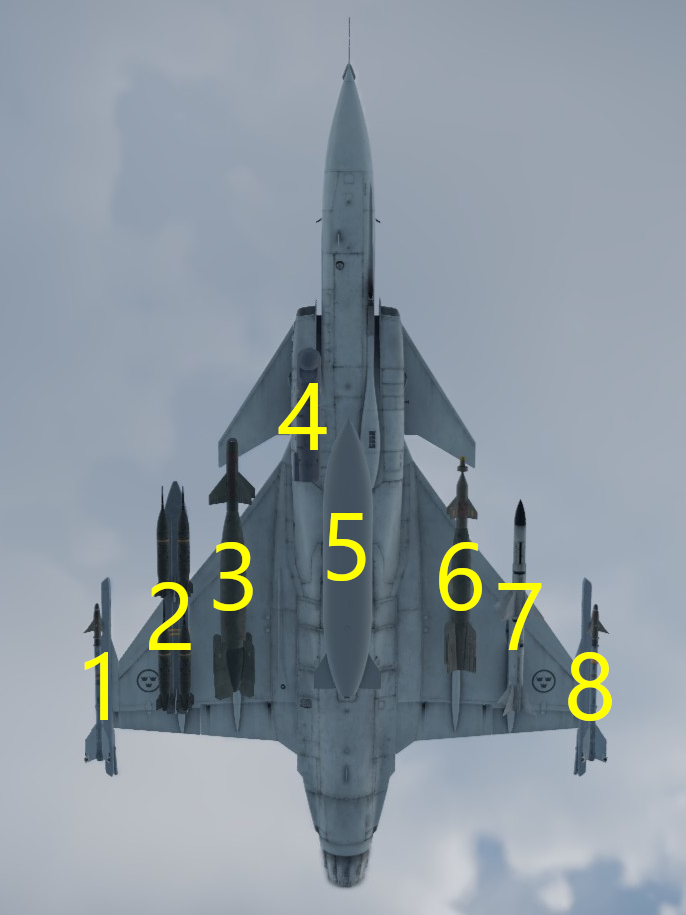JAS39C
| This page is about the Swedish jet fighter JAS39C. For other versions, see SAAB 39 Gripen (Family). |
Contents
Description
The JAS39C Gripen is a rank VIII Swedish jet fighter with a battle rating of 13.7 (AB/RB/SB). It was introduced in Update "Seek & Destroy".
General info
Flight performance
The JAS 39C Gripen is renowned for its agility, speed, and overall performance in the air, which are key attributes for any modern multirole fighter. Here’s a detailed breakdown of its aerial behavior:
Speed
The JAS 39C Gripen is a fast and nimble aircraft, with a maximum speed of approximately Mach 2 at altitude (around 2,470 km/h or 1,534 mph). This high-speed capability allows the Gripen to rapidly intercept and engage enemy aircraft or quickly retreat from hostile engagements when necessary. At lower altitudes, the speed is reduced, but the Gripen remains highly competitive, capable of sustaining high subsonic and low supersonic speeds during complex maneuvers and combat operations.
Maneuverability
One of the defining characteristics of the Gripen series, including the JAS 39C, is its exceptional maneuverability. The aircraft was designed with a relaxed static stability (RSS) configuration and utilizes a fly-by-wire (FBW) control system, which allows for greater agility and responsiveness in flight. The delta-wing design, combined with canard foreplanes, gives the Gripen a high angle of attack (AoA) capability and allows it to perform tight turns, rapid rolls, and quick transitions between different flight regimes.
In dogfights or close-range engagements, the Gripen's maneuverability is a significant advantage, enabling it to outturn and outmaneuver many contemporary fighters. The aircraft can execute high-G maneuvers with precision, which is essential for both evading incoming threats and positioning itself for an effective offensive strike.
Acceleration
The JAS 39C is powered by a single Volvo RM12 engine, which provides a thrust of about 80 kN (18,000 lbf) with afterburner. This engine offers solid acceleration performance, especially when transitioning from subsonic to supersonic speeds. While the Gripen's single-engine design means it may not accelerate as quickly as twin-engine fighters like the F-18 or Eurofighter Typhoon, it still provides sufficient thrust for rapid climbs and swift engagement of targets.
The Gripen’s light weight, coupled with its powerful engine, ensures that it can quickly reach combat speed after takeoff or during mid-mission sprints. Its acceleration is particularly notable at medium altitudes, where it can rapidly increase speed for both offensive and defensive maneuvers.
Allowable Loads
The JAS 39C Gripen is built to withstand high G-forces, with an allowable load factor typically ranging from +9G to -3G. This capability allows the aircraft to perform aggressive maneuvers without compromising structural integrity, making it a resilient platform during high-stress combat scenarios. The aircraft's design ensures that it can handle these loads consistently, which is critical for maintaining maneuverability and effectiveness during prolonged engagements.
In addition to G-load limits, the Gripen’s airframe and control systems are designed to handle the stresses associated with rapid acceleration, high-speed flight, and complex aerial maneuvers. The use of advanced materials in the airframe construction, combined with continuous monitoring by the FBW system, ensures that the aircraft remains within safe operational limits during even the most intense combat situations.
Overall Behavior in the Air
In summary, the JAS 39C Gripen is a highly agile and responsive fighter aircraft with excellent speed and maneuverability. Its design prioritizes quick, precise movements and effective handling under various combat conditions. The aircraft's acceleration, while not the highest in its class, is still competitive, allowing it to perform well in both intercept and dogfight scenarios. The Gripen’s high allowable loads and structural resilience make it a durable and reliable choice for any modern air force.
These characteristics make the JAS 39C a versatile and formidable opponent in the skies, capable of holding its own against a wide range of contemporary fighter aircraft.
| Characteristics | Max speed (km/h at 11,000 m) |
Max altitude (metres) |
Turn time (seconds) |
Rate of climb (metres/second) |
Take-off run (metres) | |||
|---|---|---|---|---|---|---|---|---|
| AB | RB | AB | RB | AB | RB | |||
| Stock | 2,169 | 2,134 | 14 500m | 25.0 | 25.5 | 213.2 | 202.8 | 500 |
| Upgraded | 2,327 | 2,240 | 23.1 | 24.0 | 279.5 | 245.0 | ||
Details
| Features | |||||
|---|---|---|---|---|---|
| Combat flaps | Take-off flaps | Landing flaps | Air brakes | Arrestor gear | Drogue chute |
| x | x | x | Yes | x | x |
| Limits | ||||||
|---|---|---|---|---|---|---|
| Wings (km/h) | Gear (km/h) | Flaps (km/h) | Max Static G | |||
| Combat | Take-off | Landing | + | - | ||
| 0 | 620 | x | x | x | ~__ | ~__ |
| Optimal velocities (km/h) | |||
|---|---|---|---|
| Ailerons | Rudder | Elevators | Radiator |
| < ___ | < ___ | < ___ | - |
Engine performance
| Engine | Aircraft mass | |||||
|---|---|---|---|---|---|---|
| Engine name | Number | Basic mass | Wing loading (full fuel) | |||
| Svenska Flygmotor RM12 | 1 | ___ kg | ___ kg/m2 | |||
| Engine characteristics | Mass with fuel (no weapons load) | Max Gross Weight | ||||
| Weight (each) | Type | _m fuel | __m fuel | __m fuel | ||
| 1054 kg | Svenska flygmotor RM12 | _,___ kg | _,___ kg | _,___ kg | _,___ kg | |
| Maximum engine thrust @ 0 m (RB/SB) | Thrust to weight ratio @ 0 m (___%/WEP) | |||||
| Condition | 100% | ___%/WEP | _m fuel | __m fuel | __m fuel | MGW |
| Stationary | 5340 | 8070 | _.__ | _.__ | _.__ | _.__ |
| Optimal | ___ kgf (_ km/h) |
___ kgf (_ km/h) |
_.__ | _.__ | _.__ | _.__ |
Survivability and armour
even though the Gripen C does not have any armour it tends to survive damage fairly well. Sometimes it can fly with missing wings, as long as you have the canards.
Modifications and economy
Armaments
| Ballistic Computer | ||||
|---|---|---|---|---|
| CCIP (Guns) | CCIP (Rockets) | CCIP (Bombs) | CCRP (Bombs) | EEGS |
| |
|
|
|
|
Offensive armament
The JAS39C is armed with:
- 1 x 27 mm Akan m/85 cannon, belly-mounted (120 rpg)
- 12 x countermeasures
- 80 x large calibre countermeasures
Suspended armament
The JAS39C can be outfitted with the following ordnance:
| 1 | 2 | 3 | 4 | 5 | 6 | 7 | 8 | ||
|---|---|---|---|---|---|---|---|---|---|
| 120 kg m/71 bombs | 4 | 4 | 4 | 4 | |||||
| 120 kg m/71 retarded bombs | 4 | 4 | 4 | 4 | |||||
| 500 lb LDGP Mk 82 bombs | 2 | 2 | 2 | 2 | |||||
| 500 lb Mk 82 Snakeye bombs | 2 | 2 | 2 | 2 | |||||
| 1,000 lb LDGP Mk 83 bombs | 1 | 1 | 1 | 1 | |||||
| 277 kg GBU-12 Paveway II bombs | 1† | 1† | 1† | 1† | |||||
| 957 kg GBU-10 Paveway II bombs | 1† | 1† | |||||||
| 1,092 lb GBU-16 Paveway II bombs | 1† | 1† | 1† | 1† | |||||
| 2,000 lb GBU-24 Paveway III bombs | 1† | 1† | |||||||
| psrak m/70 rockets | 6 | 6 | 6 | 6 | |||||
| RB 74 missiles | 1 | 1* | 1* | 1* | 1* | 1 | |||
| RB 74(M) missiles | 1 | 1* | 1* | 1* | 1* | 1 | |||
| RB 75 missiles | 1 | 1 | 1 | 1 | |||||
| RB 75T missiles | 1 | 1 | 1 | 1 | |||||
| RB 99 missiles | 1* | 1* | 1* | 1* | |||||
| Countermeasures | 160* | 160* | 160* | 160* | |||||
| LITENING II targeting pod | 1† | ||||||||
| 1,100 l drop tanks | 1 | 1 | 1 | ||||||
| Maximum permissible weight imbalance: 1,250 kg | |||||||||
| * Countermeasures can be equipped with RB 74/RB 74(M) missiles on the same hardpoint † LITENING II pod must be equipped when equipping guided bombs | |||||||||
| Default weapon presets | |
|---|---|
| |
Usage in battles
Describe the tactics of playing in the aircraft, the features of using aircraft in a team and advice on tactics. Refrain from creating a "guide" - do not impose a single point of view, but instead, give the reader food for thought. Examine the most dangerous enemies and give recommendations on fighting them. If necessary, note the specifics of the game in different modes (AB, RB, SB).
Pros and cons
Pros:
lots of countermeasures with the help of BOL pods.
very manouverable, can dogfight almost everything and win.
access to fox 3 missiles.
Cons:
Constant G-loc unless crew is highly trained
limited amount of missiles, unlike the f15 and su27
aircraft has low weight so fuel and payload affects perfomance.
JAS Gripen (JAS39C)
The JAS 39 Gripen, developed by the Swedish aerospace company Saab, is a single-engine, multi-role fighter aircraft. The Gripen is renowned for its advanced technology, cost-effectiveness, and operational flexibility. The JAS 39C is one of the latest variants of this aircraft, incorporating various upgrades in avionics, weapons systems, and electronic warfare capabilities.
/History
Development and Design
The origins of the JAS 39 Gripen date back to the late 1970s when the Swedish government recognized the need to replace its aging fleet of Saab 35 Draken and Saab 37 Viggen aircraft. In 1982, the Swedish government awarded a contract to Saab to develop a new, advanced multirole fighter that could perform air-to-air, air-to-ground, and reconnaissance missions. This new aircraft was designated JAS, an acronym derived from the Swedish words for "Fighter" (Jakt), "Attack" (Attack), and "Reconnaissance" (Spaning).
The development of the Gripen was driven by the need for a versatile, modern fighter that could operate in Sweden's unique environment. The aircraft needed to be capable of short takeoffs and landings (STOL) from dispersed bases, including roads, and had to be easy to maintain and operate in harsh conditions. Saab designed the Gripen with these requirements in mind, focusing on advanced aerodynamics, a highly integrated avionics system, and a modular structure that allowed for easy upgrades.
The first prototype of the Gripen, known as the JAS 39A, made its maiden flight on December 9, 1988. However, the program faced significant challenges during its early stages, including a crash during a test flight in 1989, which delayed the project. Saab made extensive modifications to the aircraft's flight control system, and the program resumed, leading to the introduction of the JAS 39A into the Swedish Air Force in 1996.
Introduction of the JAS 39C
The JAS 39C variant represents a significant evolution of the original Gripen design. Introduced in the early 2000s, the JAS 39C features several improvements over the JAS 39A and JAS 39B variants. These upgrades include a more advanced avionics suite, improved radar, increased fuel capacity, and the ability to carry a wider range of weapons, including precision-guided munitions. Additionally, the JAS 39C was designed to meet NATO standards, allowing it to be more easily integrated into joint operations with other NATO air forces.
The JAS 39C also incorporates a new digital cockpit, improved electronic warfare systems, and enhanced communications capabilities. These upgrades make the Gripen a more capable and versatile platform, suitable for a wide range of missions.
Operational History
The JAS 39C Gripen has seen extensive use in various air forces worldwide, with Sweden being the primary operator. The aircraft has also been exported to several countries, including Hungary, the Czech Republic, South Africa, and Thailand. The Gripen has participated in numerous international exercises and has demonstrated its capabilities in various operational scenarios.
One of the most notable operational deployments of the JAS 39C occurred during NATO's Operation Unified Protector in 2011, where the Gripen was used in combat operations over Libya. The Swedish Air Force deployed several JAS 39C aircraft to enforce the no-fly zone over Libya and conduct reconnaissance missions. The Gripen's performance in this operation was widely praised, particularly for its ability to operate efficiently and effectively in a multinational force.
The JAS 39C has also been involved in numerous other exercises and deployments, demonstrating its versatility and capability in a wide range of environments. The aircraft continues to serve as a cornerstone of the Swedish Air Force and remains in active service with several other nations.
Sources
https://no.wikipedia.org/wiki/Saab_39_Gripen
Chatgpt.com
Media
Excellent additions to the article would be video guides, screenshots from the game, and photos.
See also
Links to the articles on the War Thunder Wiki that you think will be useful for the reader, for example:
- reference to the series of the aircraft;
- links to approximate analogues of other nations and research trees.
External links
Paste links to sources and external resources, such as:
- topic on the official game forum;
- other literature.
| Swedish Aeroplane Company Ltd. (SAAB) | |
|---|---|
| Pre-SAAB: SA / ASJA | |
| SA 'Jaktfalken' | J6B |
| SAAB 17 | B17A · B17B · S17BS |
| SAAB 18 | B18A · B18B · T18B · T18B (57) |
| SAAB 21 | J21A-1 · J21A-2 · A21A-3 · J21RA · A21RB |
| SAAB 29 'Tunnan' | J29A · A29B · J29D · J29F |
| SAAB 32 'Lansen' | J32B · A32A · A32A Röd Adam |
| SAAB 35 'Draken' | J35A · J35D |
| SAAB 37 'Viggen' | JA37C · JA37D · JA37DI · JA37DI F21 · AJ37 · AJS37 |
| SAAB 39 'Gripen' | JAS39A · JAS39C |
| SAAB 105 | SK60B · SAAB-105G |
| License Production | B3C (Ju 86K) |
| Export | SAAB-105OE · J35XS · ▄JAS39C · ◔JAS39EBS HU C |
| Sweden jet aircraft | |
|---|---|
| Fighters | J21RA |
| J29A · A29B · J29D · J29F | |
| J32B | |
| J34 | |
| J35A · J35D | |
| JA37C · JA37D · JA37DI · JA37DI F21 | |
| JAS39A · JAS39C | |
| Strike aircraft | A21RB |
| A32A · A32A Röd Adam | |
| A28B | |
| AJ37 · AJS37 | |
| SK60B · SAAB-105G | |
| Export | SAAB-105OE |
| Finland | ▄Vampire FB 52A · ▄MiG-21bis · Saab J35XS |






